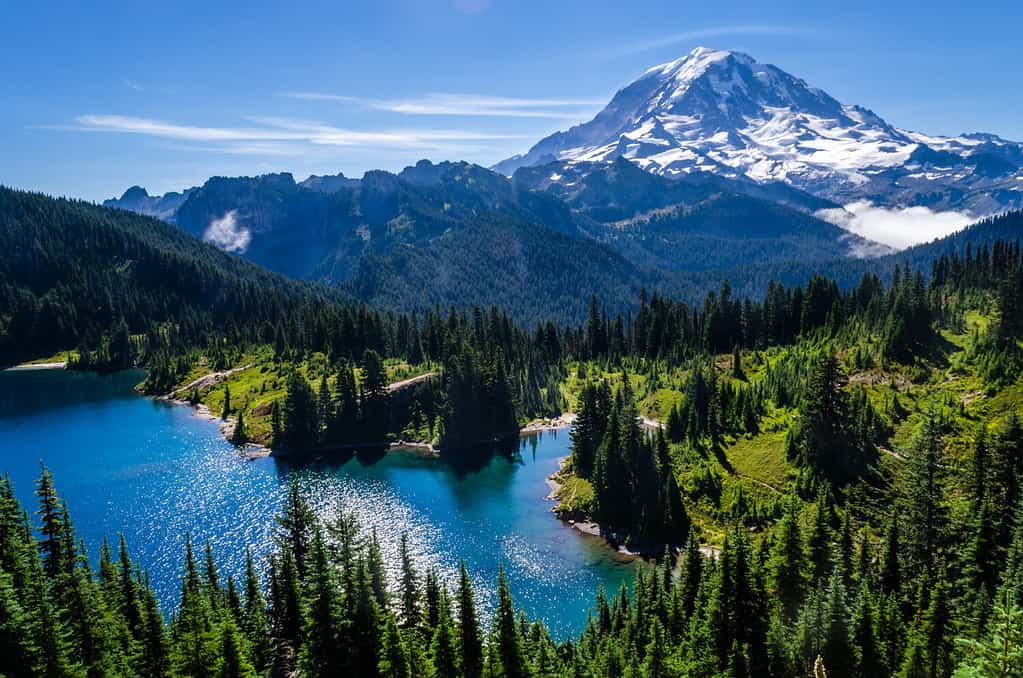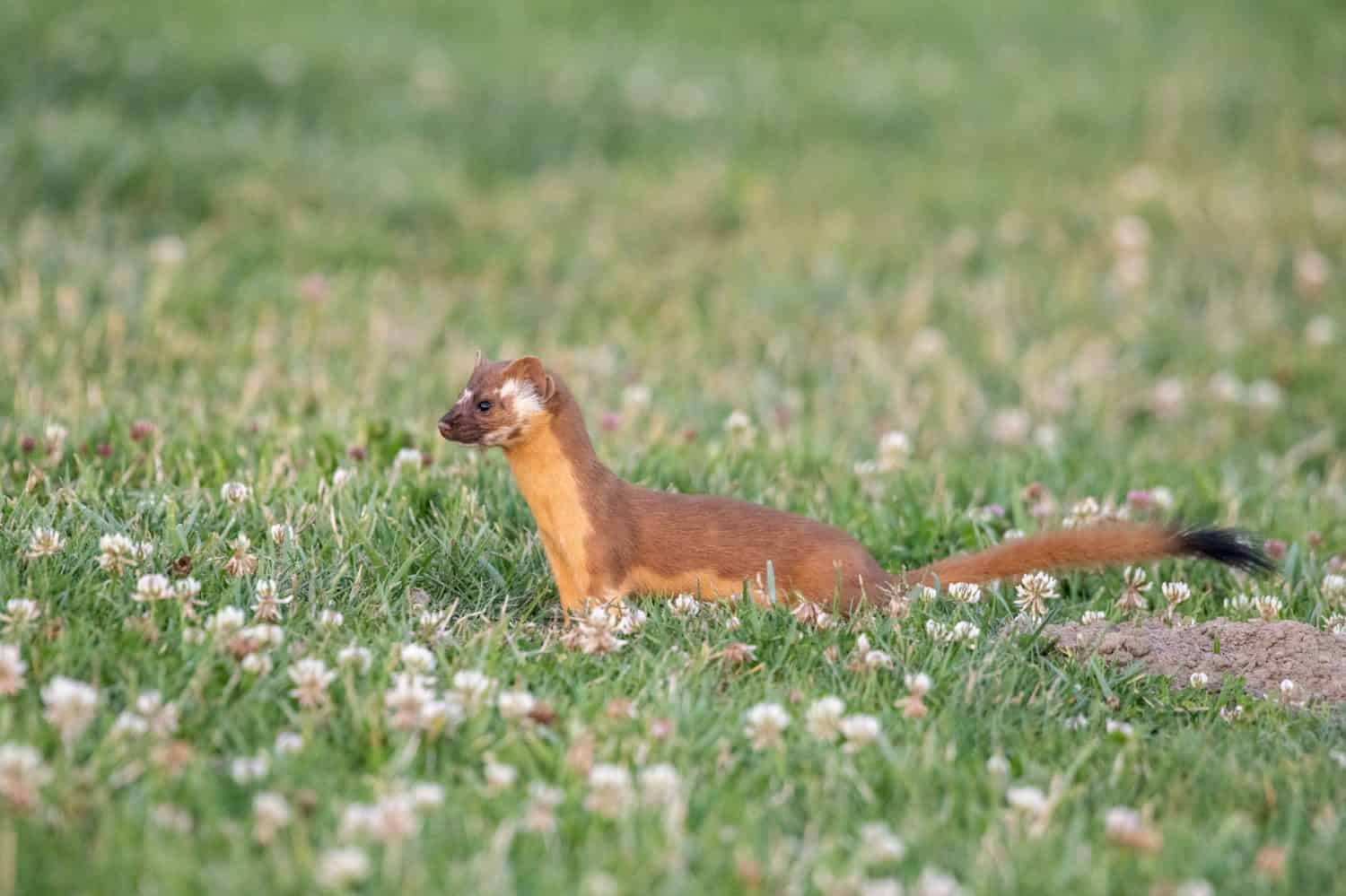One of the most scenic peaks in Washington state, Mount Rainier is a beloved destination for many. This mountain sports brilliant views, as well as a variety of natural experiences. However, just how tall is Mount Rainier?
If you’re interested in learning the answer to this question and more, continue reading below!
Mount Rainier Elevation: How Tall Is Mount Rainier?
Mount Rainier is the tallest mountain in Washington. It is also the tallest mountain in the entirety of the Cascade Range, which spans from British Columbia to northern California. So, just how tall is Mount Rainier? It has a summit elevation of 14,411 feet. Among mountaineers, this is known as a fourteener or a mountain with an elevation of over 14,000 feet.
For reference, the tallest above-sea-level mountain in the world is Mount Everest. With the highest altitude reaching 29,029 feet, this mountain is around twice that of Mount Rainier.

This mountain is the tallest of all mountains in the Cascade Range.
©KYPhua/Shutterstock.com
How Does Mount Rainier Compare to Other Mountains in the United States?
You know how Mount Rainier sizes up against the tallest mountain in the world, but how does it compare to mountains in the United States?
First, let’s start with the mountain that is technically the tallest in the world when measured from base to peak: Mauna Kea. Mauna Kea is a shield volcano located in Hawaii. At first glance, Mauna Kea’s peak is only 13,803 feet above sea level. While it is the highest point in Hawaii, it’s not even close to the height of some mountains in the world. However, that’s only when you look at the height from sea level up. You see, much of Mauna Kea’s base is actually submerged underwater. If you were to measure from the base to the peak, Mauna Kea is a whopping 30,610 feet—taller than Mount Everest and Mount Rainier.
While Mount Rainier may be smaller than Mauna Kea, it is taller than the oldest mountains in the United States. The Uwharrie Mountains in North Carolina are around 500 million years old, making them the oldest in North America. In the past, it was likely that they peaked at around 20,000 feet. However, today, thanks to millions of years of erosion, the tallest of the Uwharrie Mountains lies with High Rock Mountain, its peak sitting at 1,188 feet. As a result, it would take nearly 13 of the Uwharrie’s High Rock Mountain to reach the same height as Mount Rainier.
Wildfires on Mount Rainier
In the summer of 2023, Mount Rainier suffered from forest fires as a result of a lightning strike. Wildfires are an important part of nature’s processes, and they have been essential in shaping the landscapes and ecosystems of Mount Rainier since its formation. This fire, known as the Twin Firs Fire, occurred amidst several other wildfires at the time, which is why concern was raised.

Although frightening, carefully monitored wildfires can be beneficial for the ecosystem.
©The-Vagabond/iStock via Getty Images
Wildlife Near Mount Rainier
With widely diverse ecosystems, Mount Rainier is home to an abundance of different species. Below, learn about four interesting animals you may see when visiting the tallest mountain in Washington.
Wolverines

Wolverines are great climbers, and they are often seen resting in the evergreen trees of their forest homes.
©Lubos Chlubny/Shutterstock.com
The wolverine (Gulo gulo) is an interesting animal, and certainly a rare one at that. In fact, they are rarely found in the United States except for in Alaska, as much of their territory lies in the northernmost regions of North America and Eurasia. However, wolverines can occasionally be spotted near Mount Rainier.
The first breeding female was spotted in Mount Rainier in 2020 after nearly 100 years of being unseen within the park.
Black Bears

Most black bears have a thick coat that can look black, dark brown, grayish-blue, blond, or cinnamon.
©Mark Caunt/Shutterstock.com
The American black bear (Ursus americanus) is a National Park staple, common on both the east and west coasts of the United States. They are endemic to North America. Although uncommon in the central and southern regions of the continent, they are readily abundant near Mount Rainier. In regions where black bears are no longer found, they are locally extinct. Previously, their range used to span nearly the entirety of the United States and Canada.
Cascade Red Foxes

Cascade red foxes are found only in the state of Washington.
©Tom Reichner/Shutterstock.com
Of the wildlife discussed so far, these species can be found elsewhere in the country and world. However, the same cannot be said for the Cascade red fox (Vulpes vulpes cascadensis). This subspecies is endemic to the state of Washington. A highly rare and endangered species, they are found only in a small region within the Cascade Mountains.
Weasels

In the winter, Mount Rainier’s weasels will turn white except for the tips of their tails.
©Griffin Gillespie/Shutterstock.com
Mount Rainier is home to both short-tailed weasels (Mustela erminea) and long-tailed weasels (Mustela frenata). Their colors change with the season, individuals turning entirely white in the winter. This is from the black tip of their tails, which remains all year.
The photo featured at the top of this post is © Danita Delimont/Shutterstock.com
Thank you for reading! Have some feedback for us? Contact the AZ Animals editorial team.






